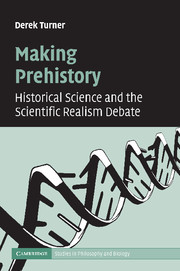Book contents
- Frontmatter
- Contents
- List of figures
- Acknowledgments
- Introduction
- 1 Asymmetries
- 2 The colors of the dinosaurs
- 3 Manipulation matters
- 4 Paleontology's chimeras
- 5 Novel predictions in historical science
- 6 Making prehistory: could the past be socially constructed?
- 7 The natural historical attitude
- 8 Snowball Earth in the balance
- Conclusion
- References
- Index
Introduction
Published online by Cambridge University Press: 22 September 2009
- Frontmatter
- Contents
- List of figures
- Acknowledgments
- Introduction
- 1 Asymmetries
- 2 The colors of the dinosaurs
- 3 Manipulation matters
- 4 Paleontology's chimeras
- 5 Novel predictions in historical science
- 6 Making prehistory: could the past be socially constructed?
- 7 The natural historical attitude
- 8 Snowball Earth in the balance
- Conclusion
- References
- Index
Summary
Much of the sound and fury in the philosophy of science over the last few decades has had to do with a view – or better, a family of views – known as scientific realism. Pick up any issue of Science magazine, and you will find reports on research dealing with microphysical entities, properties, events and processes. For example, one article in the August 19, 2005 issue includes the following claim:
When x-ray photons pass through a liquid sample that is thin compared to its x-ray absorption depth, less than 1% of the photons are scattered
(Anfinrud and Schotte 2005, p. 1192).Oversimplifying shamelessly (I will get to the finer distinctions later), the scientific realist thinks that scientists know a great many things like this, even though no one could possibly see or smell an x-ray photon, or bump into one while wandering about at night. The realist holds that a great many scientific claims like this one are true, or nearly true. Those x-ray photons are really out there, and liquids really do have x-ray absorption depths – really! And what's more, scientists did not bring any of this about; they discovered it all. What happens to photons when they pass through a liquid sample does not depend at all on what we think about photons, or on the concepts we use to think about them, or on the language we use to talk about them.
- Type
- Chapter
- Information
- Making PrehistoryHistorical Science and the Scientific Realism Debate, pp. 1 - 9Publisher: Cambridge University PressPrint publication year: 2007
- 7
- Cited by

